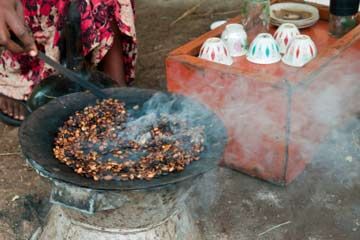Traditional Ethiopian Music
Like its people's fashion sense, the music of each of Ethiopia reflects the distinct personality of the country's various ethnic groups. Traditional music incorporates African folk sounds, but generally is less rhythmic and more string- and reed-based than that of other African countries. Ethiopian music, similar to that in neighboring countries Eritrea and the Sudan, incorporates a number of traditional instruments, the most common of which are:
- Krar: a six-stringed lyre, played with the fingers or a plectrum, which is used to pluck or strum the strings
- Washint: a simple flute
- Negarit: a kettle drum played with sticks
- Atamo: a drum tapped with the fingers or palm
Popular music trickled into the national consciousness in the 1930s when then-emperor Haile Selassie I developed Western-style military brass bands. Three decades later, the roots of American jazz, pop and soul music began to take hold as artists combined these styles with hints of traditional tunes. Dictatorial rule following Selassie's deposition led popular artists like female vocalist Aster Aweke to flee the country, but pop music has once again enjoyed mass appeal in the country since the dictatorship's collapse in 1991. Popular contemporary artists include Gigi, a female singer who fuses traditional and modern music; jazz sax player Abatte Barihun; and BBC World Music Award winner Mahmoud Ahmed [source: Pryor].
Advertisement
This, of course, is only a brief glimpse into Ethiopia's thriving traditions and culture. Check out the links on the following page for more information.
Related Articles
More Great Links
Sources
- 2020 Ethiopian Tours. "Ethiopian Weddings." (Aug. 11, 2011) http://www.2020ethiopiantours.com/index.php?option=com_content&view=article&id=86&Itemid=75
- Central Intelligence Agency (CIA). "The World Factbook." July 7, 2011 (Aug. 11, 2011) https://www.cia.gov/library/publications/the-world-factbook/geos/et.html
- Chang, Kevin O'Brien. "Reggae Routes: The Story of Jamaican Music." Temple University Press, 1998.
- Encyclopedia Coptica. "The Christian Coptic Orthodox Church of Egypt." (Aug. 11, 2011) http://www.coptic.net/EncyclopediaCoptica/
- Kobel, Paul S. "Ethiopian Americans." Every Culture. (Aug. 11, 2011) http://www.everyculture.com/multi/Du-Ha/Ethiopian-Americans.html
- Pryor, Tom. "Ethiopian Pop Music." National Geographic. (Aug. 11, 2011) http://worldmusic.nationalgeographic.com/view/page.basic/genre/content.genre/ethiopian_pop_715/en_US
- Nature News. "Ethiopia is Top Choice for Cradle of Homo sapiens." Feb. 16, 2005. (Aug. 11, 2011) http://www.nature.com/news/2005/050214/full/news050214-10.html
- Selamta. "Ethiopian Culture." (Aug. 11, 2011) http://www.selamta.net/culture.htm
- TLC. "Christmas Traditions in Ethiopia." (Aug. 11, 2011) https://tlc.howstuffworks.com/family/christmas-traditions-around-the-world-ga4.htm
- "Lost Crops of Africa: Volume I: Grains." National Research Council. National Academies Press, 1996. (Aug. 11, 2011) http://www.nap.edu/openbook.php?record_id=2305&page=215
- The University of Pennsylvania. "Africa Cookbook." (Aug. 11, 2011) http://www.africa.upenn.edu/Cookbook/Ethiopia.html
- World Flags 101. "National Flag of Ethiopia." (Aug. 16, 2011) http://www.worldflags101.com/e/ethiopia-flag.aspx


